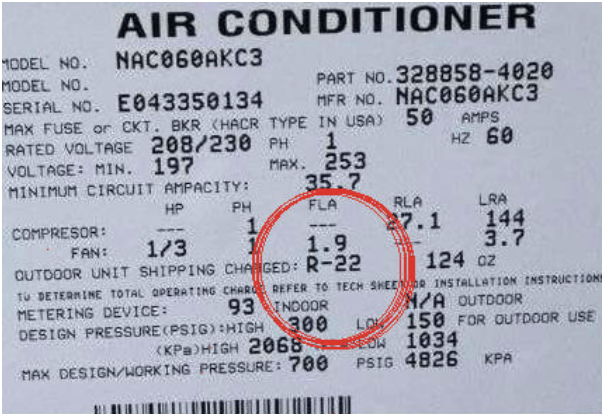The End of Freon
Freon, also known as R-22, is a refrigerant that has been in use for many decades; but since the “Clean Air Act of 1990” became law, the federal government has mandated its gradual demise. As of January 1, 2020, the production and import of Freon is now officially banned in the United States. Most homeowners have no idea that this happened; and therefore, most of them are not prepared for the future potential high costs associated with maintaining older air conditioning and heat pump units.
Prior to Freon, other types of refrigerants like ammonia were engineered for use in refrigerators; however, many of these early refrigerants were found to be toxic and flammable. Freon was invented by DuPont in 1930. Starting around 2003, most (but not all) new A/C and heat pump systems were manufactured to use Puron R-410A as their refrigerant instead of Freon. Puron complies with federal laws. Generally only Puron-using A/C and heat pump equipment have been manufactured after 2010, although a few companies did make A/C and heat pump systems that utilized R-22 after that year, but the equipment was shipped uncharged, with no Freon, from the factory. Equipment that uses Freon cannot be converted to Puron as these systems are engineered differently — Puron systems run at a much higher pressure than Freon. A simple swap-out of refrigerants is not an option. Many older chest and upright freezers and dehumidifiers also use Freon.
When inspecting homes with older R-22 based equipment installed, I always educate my clients on the Freon and Puron scenario in an attempt to prepare them. After January 1, 2020, when Freon-based equipment needs to be recharged due to a an issue like a refrigerant leak, only Freon recycled from old equipment will be available. This means Freon will be in increasingly short supply and more expensive per pound as we move further and further past 2020. Most residential A/C and heat pump systems use between three to eight pounds of Freon. The average price of Freon is between $100 to $200 per pound as of 2021 according to multiple HVAC professionals that I surveyed. If you go outside and look at your A/C or heat pump unit compressor manufacturer’s tag, it will include information about the type of refrigerant it uses. It will list either “R-22” or “HCFC 22” (Freon), or “R-410A” (Puron). Also Freon should only be worked with, reclaimed and properly disposed of by a qualified licensed contractor.The body content of your post goes here. To edit this text, click on it and delete this default text and start typing your own or paste your own from a different source.
Freon Tag:

Puron Tag:

Refrigerants allow the movement of heat energy using a refrigeration cycle which allows the refrigerant to change states from liquid to gas and vice versa. Compression or expansion of a refrigerant allows it to become hot or cold. This basic principle is how air conditioners, heat pumps, dehumidifiers and refrigerators/freezers work. They don’t create “cold” . . . instead they move heat.
A/C and heat pump systems have a general design life of about 15 years. Since R-22 equipment is now over 10 years old, putting money into a new A/C or heat pump system is often wiser than spending it to repair older cooling equipment. Of course newer A/C and heat pump systems are much more efficient with higher Seasonal Energy Efficiency Ratios, or SEER, than older systems, too, due to technology improvements. Even with a perfectly functional Freon-based A/C or heat pump system, starting to budget now for replacement of the older Freon cooling system to new Puron equipment is wise.
Matthew Steger, ACI, WIN Home Inspection
Facts, opinions and information expressed in the Closing Comments Blog represent the work of the author and are believed to be accurate, but are not guaranteed. The Lancaster County Association of Realtors® is not liable for any potential errors, omissions or outdated information. If errors are noted within a post, please notify the Association. Posts represent the author’s opinion and are not necessarily the opinion of the Association.












